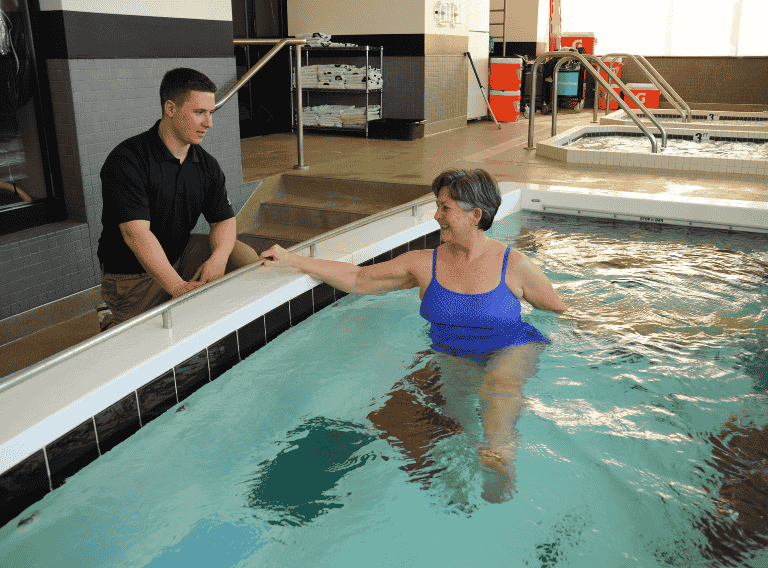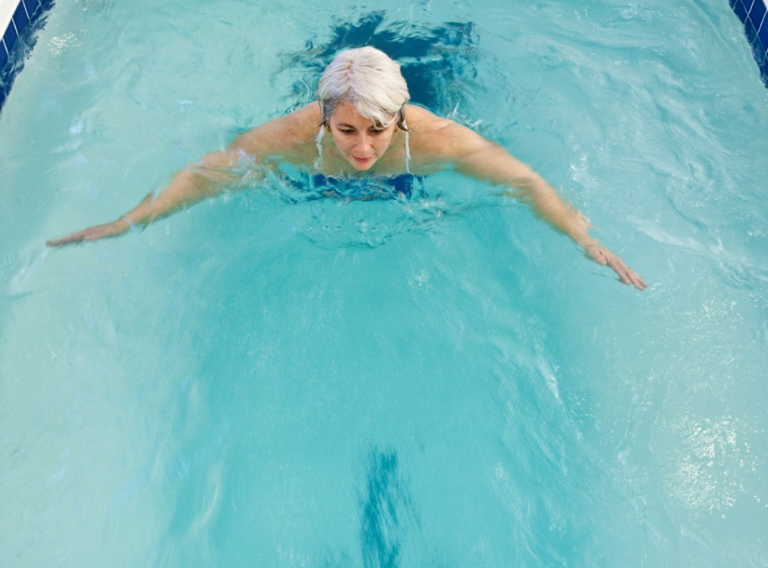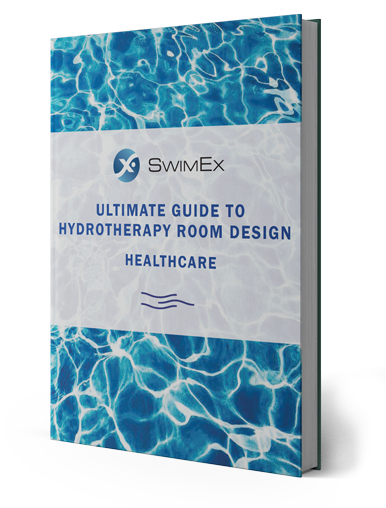
Aquatic therapy is emerging as a highly effective treatment option for individuals with Parkinson’s disease, offering several unique benefits over land-based therapies. The supportive properties of water can amplify the positive effects of exercise. This helps patients manage key symptoms while improving their overall quality of life. Let’s explore how aquatic therapy outshines traditional land-based therapies for Parkinson’s disease patients.
Improving Balance and Reducing the Fear of Falling
Water provides a safe, low-impact environment where patients can improve their balance without the fear of falling. Aquatic exercise proved more effective than land-based exercise in improving scores on the Berg Balance Scale and the Falls Efficacy Scale. [1]
Water’s buoyancy reduces the strain of gravity, giving Parkinson’s patients with gait or stability challenges a safer space to move without fear. Even if the patient stumbles, the water cushions the body, lowering the risk of injury. Water resistance and gentle use of the SwimEx paddlewheel current can provide appropriate challenges that help coordination and stability.
SwimEx therapy pools create a secure environment for rehabilitation and exercise. Patients can work through exercises more comfortably and confidently. The water’s support enables physical therapists to push patients further. They can focus on progress without the worry of injuries due to falls.
Strengthening Functional Movement
Aquatic therapy can play a transformative role in improving motor function for those with neurological conditions such as Parkinson’s disease. The natural buoyancy of the water allows for more expansive movements. Patients can practice walking with a more natural or exaggerated gait. They can also explore larger ranges of motion. Working with patients at varying water depths, adjusting their orientation to the current, and incorporating devices like kickboards provides targeted opportunities to strengthen functional movements and improve overall mobility.
Land-based exercises can strain joints and muscles. Water reduces impact while providing just enough resistance to enhance the effectiveness of movement. Patients who may struggle with mobility on land often discover that they can move more comfortably in the water, empowering them to rebuild strength and endurance.
As tremors can pose a challenge for many Parkinson’s disease patients, aquatic therapy in warm water can offer relief. The soothing temperature relaxes tight muscles. Tremors become less pronounced, giving patients more time to focus on their motor function.
Managing Pain
Aquatic therapy also offers effective pain management for individuals with Parkinson’s disease by combining the therapeutic properties of warm water with gentle exercise. The warmth helps soothe muscles, reduce stiffness, and promote relaxation, easing some of the discomfort associated with the disease. Additionally, the buoyancy of water reduces joint stress, making movements less painful while still engaging muscles. The hydrostatic pressure of water can also enhance circulation and reduce swelling, further alleviating pain.
Programs like Ai Chi [2] have been particularly effective at reducing pain perception in individuals with Parkinson’s.
Enhancing Quality of Life
Aquatic therapy for Parkinson’s patients offers more than just physical benefits—it nurtures emotional well-being and builds confidence. Because water supports and assists movement, many Parkinson’s patients discover that they can move more freely than they expected. This initial success often boosts their confidence, encouraging them to try new exercises and movements they might have previously avoided.
Water-based therapy also combines physical, cognitive, and social elements. Activities like blowing bubbles, moving in different directions on command, or engaging in conversations while exercising stimulate the mind while improving breath control and muscle coordination. Group classes in the pool promote social interaction, which can reduce feelings of isolation, anxiety, and depression—common challenges for those with chronic conditions like Parkinson’s.
The soothing effect of being submerged in warm water adds another layer of well-being. Being submerged provides not only physical relaxation but also emotional comfort, helping patients feel calmer and more in control. Much like the tranquility of a warm bath, aquatic therapy helps manage the emotional stress of living with a progressive condition. These emotional benefits, combined with improved mobility and confidence, help patients to maintain a higher quality of life.

Making the Most of Aquatic Therapy Sessions for Parkinson’s Disease
To maximize the benefits of aquatic therapy, it’s essential to prepare patients both physically and mentally. Start with a gentle warm-up and stretches before entering the water to help loosen muscles and reduce tension. Hydration plays a key role as well—patients should drink water before, during, and after sessions to prevent dehydration, which can contribute to cramping. For those prone to cramps, beginning with shorter, lower-intensity sessions allows muscles to adjust gradually. Adjusting water depth or using ankle weights for stability in shallower areas can also minimize discomfort during movement.
It’s not uncommon for patients to feel nervous when starting aquatic therapy, especially if they’ve experienced frustration with other treatments or worry about safety in the water. Clear communication about what to expect—both in and out of the pool—can ease these concerns. Sharing testimonials from other patients and walking through the therapy protocol step by step can build trust. A supportive, private environment that balances relaxation and care helps patients feel more comfortable. Music, calming colors, and humor can further reduce stress. Open dialogue ensures patients feel heard and respected throughout their sessions. By creating an environment that feels both safe and welcoming, patients can focus on building confidence and strength in the water.
Aquatic therapy offers a low-impact, supportive environment that allows patients with Parkinson’s disease to exercise more comfortably and with fewer risks. With superior outcomes in balance, motor function, and quality of life, water-based therapies are becoming an essential part of Parkinson’s care plans.
Olga, a SwimEx customer living with Parkinson’s disease, shared how aquatic therapy in her SwimEx 500 OS became a lifeline. After struggling with mobility on land, she found renewed strength and freedom in the pool, allowing her to manage symptoms more effectively. “The pool has become my haven,” Olga explains. “I feel stronger, more stable, and have less fear about what’s next.”
~ Contribution from Thomas J Marston, PT, DPT, MS. Thomas graduated with honors from Boston University College of Health and Rehabilitation Sciences in 1994, with a Master’s degree in Physical Therapy. He received his Doctorate of Physical Therapy from SUNY Upstate in 2010. He has more than 29 years of experience.
FREE GUIDE
Hydrotherapy For Healthcare
The ultimate guide for designing and planning a room for your healthcare facility from start to finish.

- Cugusi L, Manca A, Bergamin M, et al. Aquatic Exercise Improves Motor Impairments in People With Parkinson’s Disease, With Similar or Greater Benefits Than Land-Based Exercise: A Systematic Review. Journal of Physiotherapy. 2019;65(2):65-74. doi:10.1016/j.jphys.2019.02.003.
- Pérez de la Cruz S. Effectiveness of Aquatic Therapy for the Control of Pain and Increased Functionality in People With Parkinson’s Disease: A Randomized Clinical Trial. European Journal of Physical and Rehabilitation Medicine. 2017;53(6):825-832. doi:10.23736/S1973-9087.17.04647-0.
